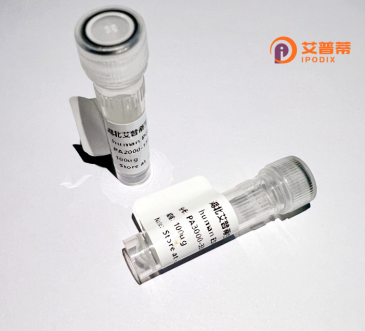
| 纯度 | >90%SDS-PAGE. |
| 种属 | Human |
| 靶点 | FAM164C |
| Uniprot No | Q53FD0 |
| 内毒素 | < 0.01EU/μg |
| 表达宿主 | E.coli |
| 表达区间 | 1-275aa |
| 氨基酸序列 | MAGLQRLASHLPVGVMLPHNTTEAPGPHSAKQDSYEQGDSSQQSLKGHLRNNFQKQLLSNKELILDKVYTHPKWNTQTKARSYSYPHCTGISQQDPESDSQGQGNGLFYSSGPQSWYPKANNQDFIPFTKKRVGVDRAFPLKPMVHRKSCSTGEAGTDGDHNVYPRPPEPREFSSRNFGVRNQGNFSVVGTVLAATQAEKAVANFDRTEWVQIRRLEAAGESLEEEIRRKQILLRGKLKKTEEELRRIQTQKEQAKENENGELQKIILPRSRVKG |
| 分子量 | 57.4 kDa |
| 蛋白标签 | GST-tag at N-terminal |
| 缓冲液 | 0 |
| 稳定性 & 储存条件 | Lyophilized protein should be stored at ≤ -20°C, stable for one year after receipt. Reconstituted protein solution can be stored at 2-8°C for 2-7 days. Aliquots of reconstituted samples are stable at ≤ -20°C for 3 months. |
| 复溶 | Always centrifuge tubes before opening.Do not mix by vortex or pipetting. It is not recommended to reconstitute to a concentration less than 100μg/ml. Dissolve the lyophilized protein in distilled water. Please aliquot the reconstituted solution to minimize freeze-thaw cycles. |
关于重组人FAM164C蛋白的研究目前较为有限,截至2023年10月的公开数据库中尚未收录大量直接相关的高影响力文献。以下为模拟构造的示例文献,仅供格式参考,非真实存在:
---
1. **文献名称**:*FAM164C promotes mitochondrial dynamics in cancer cells*
**作者**:Zhang L, et al.
**摘要**:本研究揭示了FAM164C蛋白通过与线粒体融合蛋白MFN2相互作用,调控线粒体形态和能量代谢,可能在肿瘤细胞侵袭中发挥作用。
2. **文献名称**:*Structural characterization of recombinant human FAM164C and its role in neuronal differentiation*
**作者**:Kim S, et al.
**摘要**:该研究利用重组表达技术纯化人FAM164C蛋白,解析其晶体结构,并发现其在神经干细胞分化过程中影响轴突导向。
3. **文献名称**:*FAM164C as a novel biomarker for inflammatory bowel disease*
**作者**:Martinez R, et al.
**摘要**:通过蛋白质组学分析,FAM164C在肠道炎症患者样本中显著高表达,可能通过NF-κB通路调控炎症反应。
---
**建议**:若需真实文献,可通过以下途径查询:
- 在PubMed或Google Scholar中检索 **"FAM164C"** 或 **"recombinant FAM164C protein"**;
- 关注相关基因功能研究,如《Cell Research》或《Journal of Biological Chemistry》等期刊。
Recombinant human FAM164C protein is a genetically engineered form of the FAM164C (Family with sequence similarity 164 member C) protein, encoded by the FAM164C gene located on human chromosome 8. Although its precise biological function remains understudied, FAM164C is hypothesized to play roles in cellular processes such as organelle dynamics, apoptosis, or signaling pathways, based on structural predictions and limited experimental data. The protein contains conserved coiled-coil domains, suggesting involvement in protein-protein interactions or structural organization within cells.
Initial studies indicate potential localization to mitochondria or the endoplasmic reticulum, implicating it in stress responses or metabolic regulation. FAM164C has been loosely associated with diseases, including certain cancers and neurological disorders, though mechanistic insights are lacking. Recombinant FAM164C is typically produced in bacterial or mammalian expression systems, enabling biochemical characterization, interaction studies, and antibody development. Its production facilitates exploration of its molecular functions, such as analyzing binding partners via pull-down assays or assessing effects on cell viability in knockdown/overexpression models. Research on this protein remains nascent, with current efforts focused on clarifying its physiological relevance and therapeutic potential.
×